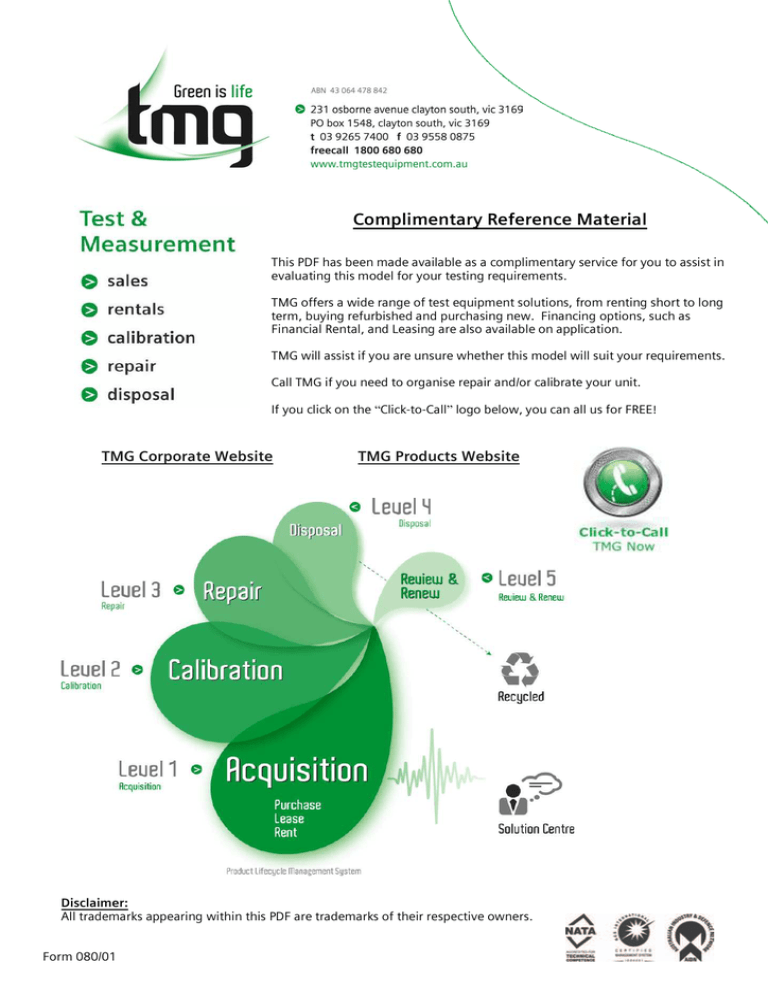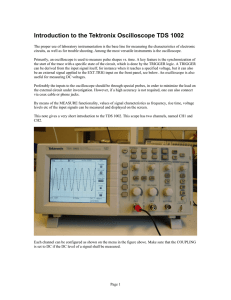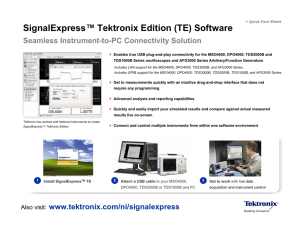
Complimentary Reference Material
This PDF has been made available as a complimentary service for you to assist in
evaluating this model for your testing requirements.
TMG offers a wide range of test equipment solutions, from renting short to long
term, buying refurbished and purchasing new. Financing options, such as
Financial Rental, and Leasing are also available on application.
TMG will assist if you are unsure whether this model will suit your requirements.
Call TMG if you need to organise repair and/or calibrate your unit.
If you click on the “Click-to-Call” logo below, you can all us for FREE!
TMG Corporate Website
TMG Products Website
Disclaimer:
All trademarks appearing within this PDF are trademarks of their respective owners.
Form 080/01
TDSCEM1
Communications Eye-diagram Measurements Software
Features and Benefits
• Perform Automatic Eye Diagram
Measurements of: % Crossing, Eye Height,
Eye Width, Quality Factor, Extinction Ratio
and Jitter.
• Provides More In-depth Understanding of
Your Communication Signal Beyond
Qualitative Pass/Fail Mask Testing
• Adds Additional Capability to Your TDS
Communications Analyzer Package by
Enabling Your TDS 500/700 Series
Oscilloscope to Perform Automated Eye
Diagram Measurements
• Optical Standards Measured Include:
– SONET/SDH: OC1/STM0, OC3/STM1,
OC12/STM4
– Fibre Channel: FC133, FC266, FC531,
FC1063
– Gigabit Ethernet: 1.25 Gb/s
• With the Unique Autoset to Standard Mask
Capability, You Do Not Need to Set Up the
Vertical, Horizontal, Trigger or Filter
Controls
• Set the Population Size for the Statistics
Measurements
• Log the Measurement Results to a File for
Future Analysis
• GPIB Control of Measurements for Use in
ATE Applications
• Installs Inside the TDS Oscilloscope
Requiring no External GPIB, RS-232 or PC
Applications
• Characterize the Quality of Your Optical
Communications Signals with Accurate Eye
Diagram Analysis
USER-INSTALLED, OSCILLOSCOPE RESIDENT
EYE DIAGRAM MEASUREMENT PACKAGE
Option 2C, the Tektronix TDS Communication
Signal Analyzer package, gives you the most
comprehensive oscilloscope solutions for
connecting to, capturing, and characterizing
optical and electrical signals in high-speed
communication designs. Based on the
TDS 500D/700D family of Digital Phosphor
Oscilloscopes (DPOs), Option 2C and various
measurement accessories tailor the oscilloscope for engineers debugging, characterizing, and verifying the compliance of communication systems to international standards.
TDSCEM1 adds additional capability to
Option 2C by allowing communication customers to perform quantitative measurements
on their eye diagrams in addition to qualitative
mask testing. TDSCEM1 provides an extenHistogram
Box 1
Ptop
Histogram
Box 3
Pcross
P base
T cross1
Histogram
Box 2
Tcross2
See Tektronix on the World Wide Web:
http://www.tektronix.com
1
•
E y e - d i a g r a m
M e a s u r e m e n t s
S o f t w a r e
sive suite of additional measurements to support analysis and trouble-shooting beyond
simple pass-fail testing.
The following diagram and text describe the
measurements performed:
Tcross1 = time at which the first crossing
occurs.
Tcross2 = time at which the second crossing
occurs.
Ptop = mean of the most predominant peak in
the histogram for box 1.
Pbase = mean of the most predominant peak in
the histogram for box 2.
Pcross = level at which the first crossing
occurs.
• Crossing % is the location of the zero
crossing as a % of the eye opening
– Crossing % = 100 [(Pcross – Pbase)/
(Ptop – Pbase)]
• Eye Height is the vertical opening of the eye
– Eye height = (Ptop – 3σtop) –
(Pbase + 3σbase)
• Eye Width is the the horizontal opening of
the eye
– Eye width = (Tcross2 – 3σcross2) –
(Tcross1 + 3σcross1)
• Quality Factor is the vertical opening of the
eye relative to the noise present
– Quality factor = (Ptop – Pbase)/(σtop + σbase)
TDSCEM1
Communications Eye-diagram Measurements Software
CH AR ACTER I STI CS
• Extinction Ratio is the ratio of the average
high logic level to the average low logic
level. In the Option 2C extinction ratio measurement, the Ptop and Pbase levels are determined by using all high logic levels and all
low logic low levels. In the TDSCEM1 application, the Ptop and Pbase levels are determined by using the middle 20% of the eye
opening. In addition, the TDSCEM1 extinction ratio measurement allows the user to
determine the statistical population size
before the measurement is performed.
– Ext ratio = Ptop/Pbase
– Ext Ratio % = 100[(Pbase – Pdark)/
(Ptop – Pdark)]
– Ext Ratio dB = 10 Log [(Ptop – Pdark)/
(Pbase – Pdark)]
• Jitter is the time variation of the signal zero
crossing
– Jitter RMS = σ
– Jitter 6sigma = 6σ
– Jitter PP = max – min
Customers who will benefit from TDSCEM1
are electronic design engineers working for
communication equipment manufacturers in
the communications industry who develop
products with standard communication interfaces. These engineers need tools to properly
characterize their designs and verify compliance to industry standards. These standards
include SONET/SDH, Fibre Channel and
Gigabit Ethernet. Characterization of these
optical and electrical signals include mask
testing as well as eye diagram measurements.
TDSCEM1 comes on a single floppy disk, is
easily installed in a TDS oscilloscope, and
doesn’t require any external processing or
connections. After installation, the application
is accessible from the oscilloscope front
panel.
TEKTRONIX DIGITAL OSCILLOSCOPES
SUPPORTED
TDS 500D, TDS 700D series oscilloscopes
with Communication Signal Analyzer
Option 2C and a hard disk drive (Option HD
or Option 2M).
O R D ER I N G I N FO R M ATI O N
TDSCEM1
Communications Eye Diagram Measurement
Software for TDS 500/700 Oscilloscopes.
Includes: Software on a 3.5-in. Disk, Manual.
TDSCEM1 RECOMMENDED OPTIONS
AND ACCESSORIES
AMT75 – 75 Ω Adapter.
TDS Option 3C – (includes P6701B) Shortwavelength Fibre Channel Optical Reference
Receiver.
TDS Option 4C – (includes P6703B) Longwavelength SONET/SDH Optical Reference
Receiver.
P6701B/P6703B – Optical-to-Electrical Converters.
P6723 – Optical Logic Probe.
OA5002/OA5012/OA5022/OA5032 – Optical
Attenuators.
For further information, contact Tektronix:
Worldwide Web: for the most up-to-date product information visit our web site at: www.tektronix.com
ASEAN Countries (65) 356-3900; Australia & New Zealand 61 (2) 9888-0100; Austria, Central Eastern Europe, Greece, Turkey, Malta,& Cyprus +43 2236 8092 0; Belgium +32 (2) 715 89 70;
Brazil and South America 55 (11) 3741-8360; Canada 1 (800) 661-5625; Denmark +45 (44) 850 700; Finland +358 (9) 4783 400; France & North Africa +33 1 69 86 81 81; Germany + 49 (221) 94 77 400;
Hong Kong (852) 2585-6688; India (91) 80-2275577; Italy +39 (2) 25086 501; Japan (Sony/Tektronix Corporation) 81 (3) 3448-3111; Mexico, Central America, & Caribbean 52 (5) 666-6333;
The Netherlands +31 23 56 95555; Norway +47 22 07 07 00; People’s Republic of China 86 (10) 6235 1230; Republic of Korea 82 (2) 528-5299; South Africa (27 11)651-5222; Spain & Portugal +34 91 372 6000;
Sweden +46 8 477 65 00; Switzerland +41 (41) 729 36 40; Taiwan 886 (2) 2722-9622; United Kingdom & Eire +44 (0)1628 403300; USA 1 (800) 426-2200.
From other areas, contact: Tektronix, Inc. Export Sales, P.O. Box 500, M/S 50-255, Beaverton, Oregon 97077-0001, USA 1 (503) 627-6877.
Copyright © 1999, Tektronix, Inc. All rights reserved. Tektronix products are covered by U.S. and foreign patents, issued and pending. Information in this
publication supersedes that in all previously published material. Specification and price change privileges reserved. TEKTRONIX and TEK are registered
trademarks of Tektronix, Inc. All other trade names referenced are the service marks, trademarks or registered trademarks of their respective companies.
6/99
HB/XBS
55W-13333-0
2 •
E y e - d i a g r a m
M e a s u r e m e n t s
S o f t w a r e





